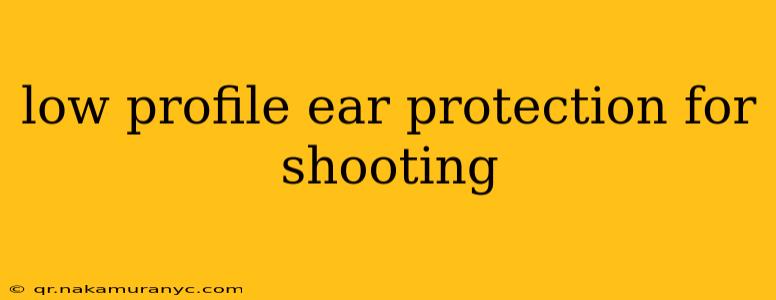Choosing the right hearing protection is crucial for any shooter, regardless of experience level. While bulky earmuffs offer excellent protection, they can be cumbersome and interfere with situational awareness, especially in tactical shooting or hunting situations. This is where low-profile ear protection comes into its own. This guide delves into the features, benefits, and considerations of choosing the best low-profile ear protection for your shooting needs.
Understanding the Need for Low-Profile Ear Protection
Traditional over-the-ear muffs, while effective, can present several challenges:
- Limited Situational Awareness: The bulkiness can hinder the ability to hear important ambient sounds like commands or approaching wildlife.
- Comfort and Fit: Extended wear can lead to discomfort and pressure points.
- Interference with Other Gear: They might clash with helmets, hats, or other accessories.
Low-profile ear protection addresses these issues by offering a more discreet and comfortable alternative. They are designed to provide adequate hearing protection without sacrificing situational awareness or comfort.
Types of Low-Profile Hearing Protection
Several types of low-profile hearing protection are available for shooters:
1. Low-Profile Earmuffs:
These are smaller and sleeker than traditional muffs, often featuring a more compact design and lighter weight. They still offer significant noise reduction, albeit usually slightly less than their bulkier counterparts. Look for features like:
- Foldable Design: For easy storage and portability.
- Adjustable Headbands: Ensuring a comfortable and secure fit.
- Noise Reduction Rating (NRR): This indicates the level of noise reduction the muffs provide. Higher NRR generally means better protection.
2. Earplugs:
Earplugs come in various forms, including:
- Foam Earplugs: Disposable and inexpensive, these are readily available and offer decent noise reduction. However, they can be less comfortable for extended wear.
- Silicone Earplugs: Reusable and more durable than foam, offering a better fit and potentially higher NRR.
- Custom-Molded Earplugs: These are professionally fitted to your ears, providing the most comfortable and effective noise reduction. They are the most expensive option but are highly valued by many shooters for long-range shooting and competitions.
Key Factors to Consider When Choosing Low-Profile Ear Protection
Several crucial factors influence the choice of low-profile ear protection:
- Noise Reduction Rating (NRR): The higher the NRR, the more noise reduction provided. Choose a rating appropriate for your shooting environment and firearm.
- Comfort and Fit: A comfortable fit is essential, especially for extended use. Consider the material and design for long-term wearability.
- Situational Awareness: Low-profile options generally offer better situational awareness than bulky muffs.
- Durability and Longevity: Invest in durable ear protection that will withstand regular use and potential impacts.
- Price: Prices vary greatly depending on the type and features of the ear protection. Balance your budget with your needs and desired level of protection.
Maintaining Your Low-Profile Ear Protection
Proper care extends the lifespan of your ear protection and ensures continued effectiveness:
- Cleaning: Regular cleaning is crucial to maintain hygiene and remove debris. Check manufacturer instructions for specific cleaning recommendations.
- Storage: Store your ear protection in a protective case to prevent damage and extend its lifespan.
- Inspection: Periodically inspect your ear protection for any signs of wear and tear.
Conclusion: Finding the Perfect Fit
Selecting the right low-profile ear protection is a personal decision based on individual needs and preferences. By carefully considering the factors outlined above, you can find the perfect balance between hearing protection, comfort, and situational awareness, ensuring both your safety and enjoyment on the range. Remember, hearing loss is permanent—protect your hearing!
